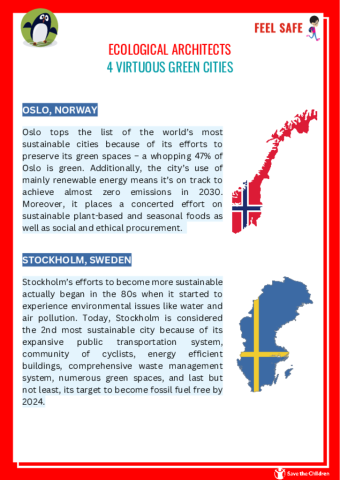Ecological Architects
Objectives:
- Increase awareness of energy consumption in buildings and their environmental impact
- Learn about the various types of energy supplies and how to optimize the use of resources
- Understand the connection between energy consumption, buildings and climate change
Before starting
The teacher introduces the concept of sustainable cities and circular cities. Sustainable cities are urban models that aim to make spaces more efficient, digitized, habitable, and interconnected, with the goal of being inclusive, safe, and resilient by 2030, as envisioned by the UN Sustainable Development Goals. Circular cities represent an evolution of smart cities, building on the circular economy, which eliminates the concept of waste and promotes sharing, reuse, repair and recycling.
To achieve these goals, it is essential to:
- Develop environmentally friendly transportation, considering the needs of the most vulnerable
- Involve citizens in urban planning and improvement
- Protect and enhance cultural and scenic heritage
- Provide safe and high-quality housing
- Managing waste and controlling air quality
- The use of renewable and energy-efficient materials is crucial
Environmentally sustainable materials must:
- Be durable
- Be reusable in the construction or dismantling of buildings
- Be produced with low energy consumption
- Not contain hazardous chemicals and be safe for health and the environment
- Improve the indoor climate of buildings
- Be recyclable
- Offer energy efficiency, reducing heating and electricity costs
Resilient cities
What is a sustainable city?
To begin, a sustainable city is one that considers its social, environmental, and economic impact through careful urban planning and management. Sustainable cities are designed to reduce their harmful impact on the environment and advocate a circular economy.
In short, sustainable cities promote sustainable living through a multidisciplinary approach that considers people, planet, and profit – often referred to as the “3Ps” of sustainability Development that ensures that the needs of the present generation are met without compromising the ability of future generations to meet their own needs .
There are already cities that practice a green approach. The Global Destination Sustainability Index (link) reveals the destinations that are working towards a sustainable and lower-carbon future.
The teacher can share four examples of sustainable cities (see "Ecological Architects - 4 Virtuous Green Cities" below) and share thoughts with the class.
My eco-sustainable neighborhood
In this activity, students will be involved in designing and implementing a model of an environmentally sustainable neighborhood using recycled materials to physically recreate the project.
The teacher begins by showing images of real and futuristic neighborhoods that have adopted green practices, explaining how elements such as green spaces, recycled materials and sustainable energy technologies contribute to the creation of sustainable urban environments.
Students, divided into groups, discuss what features would make a neighborhood greener and how to incorporate green materials and technologies into their design.
The following steps can be used to guide the groups' work:
-
Project planning:
- Each group chooses a neighborhood in their city or imagines a new neighborhood they would like to redesign. The group will have to decide how to transform it into an eco-friendly area.
- Groups consider various aspects: using low-impact materials, creating green spaces, implementing solar panels and rainwater harvesting systems, etc.
- Groups must also think about solutions for waste management and improving building energy efficiency.
-
Model making:
- Using reclaimed materials such as cardboard boxes, plastic bottles, caps, cloth, and other recycled items, each group builds a three-dimensional model of their eco-sustainable neighborhood.
- Groups should render buildings, green areas, and green solutions they have designed, trying to be as detailed as possible
- Presentation and discussion:
- Once the models are completed, each group presents their project to the class, explaining the ecological choices they made and how these contribute to the sustainability Development that ensures that the needs of the present generation are met without compromising the ability of future generations to meet their own needs of the neighborhood.
- Each presentation is followed by a question-and-answer session, where classmates and the teacher can offer feedback and suggestions.
- The teacher leads a final discussion on the ecological choices of the various projects, highlighting best practices and innovative ideas that have emerged.
Concluding thoughts
The teacher emphasizes how designing environmentally sustainable neighborhoods is not just a creative exercise, but a real necessity to address the environmental challenges of our time. The models made by the groups demonstrate that it is possible to imagine and build urban spaces that are both functional and environmentally friendly. Each project showed how material choices, the integration of green spaces and the use of sustainable technologies can help create more resilient and livable communities.
The teacher suggests final stimulus questions to conclude the activity:
- What green solutions did you find most innovative or interesting and why?
- What were the main challenges you faced in designing your eco-sustainable neighborhood?
- How could the design you made be applied or adapted to the reality of your current neighborhood?

Add new comment